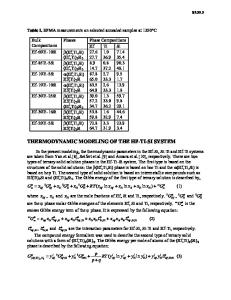Experimental investigation and thermodynamic calculation of the phase equilibria in the Cu-Sn and Cu-Sn-Mn systems
- PDF / 387,556 Bytes
- 14 Pages / 606.24 x 786 pts Page_size
- 104 Downloads / 330 Views
27/4/04
17:01
Page 1641
Experimental Investigation and Thermodynamic Calculation of the Phase Equilibria in the Cu-Sn and Cu-Sn-Mn Systems X.J. LIU, C.P. WANG, I. OHNUMA, R. KAINUMA, and K. ISHIDA The phase equilibria in the Cu-rich portion of the Cu-Sn binary and Cu-Sn-Mn ternary systems have been determined using the diffusion-couple method, differential scanning calorimetry (DSC), high-temperature electron diffraction (HTED), and high-temperature X-ray diffraction (HTXRD) techniques. The present experimental results on the binary Cu-Sn system show the presence of the two-stage, second-order reaction A2 → B2 → D03 in the bcc-phase region, rather than a two-phase equilibrium between the disordered bcc (A2) and the ordered bcc (D03) phases, as reported before. Phase equilibria in the Cu-Sn-Mn ternary system in the composition range of 0 to 30 at. pct Sn and 0 to 30 at. pct Mn at 550 °C, 600 °C, 650 °C, and 700 °C have been determined, and a ternary compound (Cu4MnSn) with a very small solubility has been detected. A thermodynamic analysis of the Cu-Sn-Mn ternary system including the Cu-Sn and Mn-Sn binary systems has also been carried out by the CALPHAD (Calculation of Phase Diagrams) method, in which the Gibbs energy of the bcc phase is described by the two-sublattice model in order to take into account the second-order A2/B2 ordering reaction. A consistent set of optimized thermodynamic parameters for the Cu-Sn-Mn system for describing the Gibbs energy of each phase results in a better fit between calculation and experiment.
I.
INTRODUCTION
COPPER-TIN alloys, also known as tin bronzes, have been widely used in many applications for a long time because of their wide range of desirable properties. Most recently, a number of investigations have been carried out to design Pb-free Sn-based soldering alloys for microelectronics application. The fact that such Pb-free Sn-based soldering alloys are to be used in establishing electrical contacts between metals, of which one is invariably copper, means that an accurate knowledge of the phase equilibria in the Cu-Sn base alloys is very important for understanding the reaction between the Cu substrate and the Sn-based solders. However, from the available reviews on the phase diagram,[1–4] it is clear that the Cu-Sn phase diagram is based on the experiments performed before 1940, mainly by means of thermal analysis and metallography.[5–16] Figure 1 is the Cu-Sn binary phase diagram from the review by Saunders and Miodownik,[3,4] showing a narrow  ⫹ ␥ region in the Curich portion where the  (A2) and ␥ (D03) phases co-exist. A careful reappraisal of the earlier results raises the following questions. 1. /␥ phase equilibrium: Some of the crucial results on the /␥ phase equilibrium in the Cu-rich portion show that there are discrepancies in the earlier results.[5–10] Hamasumi and Nishigori[9] first reported the existence of a second-order reaction on the basis of their thermal-expansion and thermalresistance experimental results. They, however, retracted this conclusion
Data Loading...











